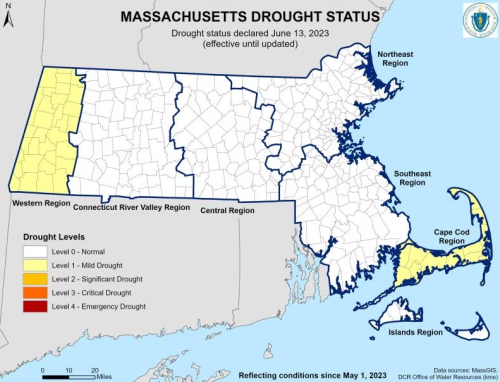DROUGHT STATUS UPDATES
Updates will be added to the BOTTOM of the page as they become available.
If you see or witness a fire becoming out of control, call 911 immediately to report it - do not hesitate, every second counts!
Please see below for press releases from the Massachusetts Executive Office of Energy and Environmental Affairs.
For more information on drought status, please visit this page for MA specific information.
You can visit this page for information on heat-related health risks from the National Integrated Heat Health Information System.
You can visit this page for the nation-wide US Drought Monitor.
For questions on what this drought status means for you as an Applicant, please contact the Conservation Agent by phone (978-465-0862, ext 310), email ([email protected]), or stop by the office at 12 Kent Way, Suite 101, in Byfield.
ORIGINAL RELEASE: JUNE 13, 2023
PLEASE NOTE: At the time of this press release, the Northeast Region is not being impacted by any drought status. Under the state declaration, we currently sit at Level 0-Normal conditions. This page is being provided as a general reference to advise of the state-wide drought conditions.
EEA Secretary Rebecca Tepper has declared a Level 1-Mild Drought status for the Western and Cape Cod regions of Massachusetts following more than two months of below-normal rainfall and above-normal temperatures. All other regions currently remain at a Level 0-Normal status. However, according to the MA Drought Management Plan, the current Level 1-Mild status in the Western and Cape Cod regions warrants detailed monitoring of drought conditions.
Secretary Tepper is already urging residents and businesses across the state to be mindful of water usage as we draw into the growing and recreational season, noting that "it's important that we all work together to conserve water". Acting MEMA Director Dawn Brantley also stated, “While the Commonwealth has experienced some recent beneficial rainfall, the last 60 days have been overall slightly drier than average. Dry conditions increase the threat of brush and wildland fires, as Massachusetts saw during last year’s extended drought and widespread brush fires, so it’s especially important during the summer months to exercise caution with any open flames during outdoor activities.”
Over the past several months, rainfall events in the state have been irregular, but state officials anticipate improvements in these areas based on rains this week. The drought declaration in the Western and Cape Cod regions was informed by recommendations and discussions during the Drought Management Task Force meeting held on June 8, 2023. The declaration will remain in place until water levels return to normal.
For information on recommendations for those living in areas impacted by droughts, please visit this page. These recommendations are provided by state agencies, and will help to greatly reduce water use to ensure essential needs, such as drinking water and fire protection, are being met, habitats have enough water to support natural functions, and sustain the Commonwealth's water supplies. MassDEP also provides technical assistance to communities on managing systems, including assistance on the use of emergency connections and water supplies.
MassDEP Commissioner Bonnie Heiple notes that “While rain has been plentiful this spring in many areas of the state, that has not been the case in the western region or on the Cape. Now is the time to implement sound conservation measures to manage water demands and help minimize larger problems later in the summer should dry conditions continue.”
The Drought Management Task Force will meet again on July 6, 2023 at 10:00 AM, and state agencies will continue to monitor and assess conditions across the state. For more information on water conservation and what residents can do, check out the EOEEA's drought and water conservation pages.
To view the full press release, click here.


